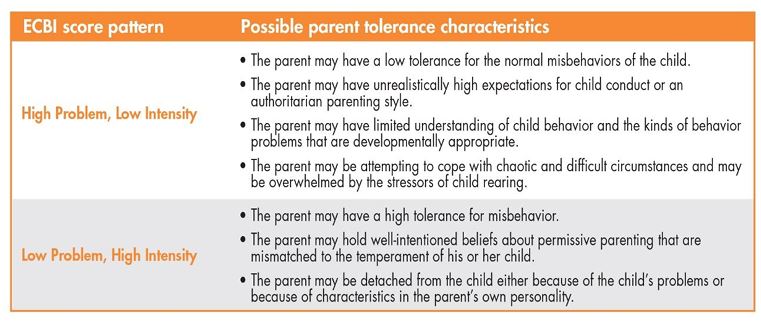Sheila Eyberg, PhD; Professional Manual by Sheila Eyberg, PhD, and Donna Pincus, MA
At Home and in School, Distinguish Common Behavior Problems from Conduct-disordered Behavior
The ECBI and the SESBI-R are comprehensive, behaviorally specific rating scales that assess the frequency and severity of disruptive behaviors in the home and school settings, as well as the extent to which parents and/or teachers find the behavior troublesome. By evaluating the variety and frequency of behaviors commonly exhibited by all children, the instrument distinguishes normal behavior problems from conduct-disordered behavior in children and adolescents.
Overview
- The ECBI and SESBI-R are companion behavioral rating scales for children ages 2 to 16 years.
- Measures identify conduct problems such as noncompliance, defiance, aggressiveness, and impulsiveness.
- When used together, the measures provide clinicians with information that is useful in the identification and treatment of conduct-disordered behaviors including attention deficit/hyperactivity disorder (ADHD), oppositional defiant disorder (ODD), and conduct disorder (CD).
- Contains items that are non-age-specific and common in all children.
Features and benefits
- Evaluates in relevant environments. The ECBI is designed for completion by parents and assesses the child’s or adolescent’s behavior at home; the SESBI-R is designed for completion by teachers and assesses the child’s or adolescent’s behavior at school.
- Widely generalizable. Both instruments contain items that represent common behaviors in all children. Plus, items are non-age-specific, ensuring commensurate results regardless of age.
- Simple, fast scoring. ECBI and SESBI-R scores can be quickly and easily computed by hand in about 5 minutes each. The ECBI Score Report includes item response descriptions, see the resources tab for a sample of the revised ECBI score report.
- Versatile administration. Completion of each rating sheet requires a 6th-grade reading level. Both instruments also are suitable for group administration or for administration via telephone.
- Provides supplemental information. Because they measure both the frequency of each problem behavior and the parent’s or teacher’s reaction to the child’s behavior, the ECBI and SESBI-R may provide additional insights into areas of the adult–child interaction that should be addressed.
- Allows for easy progress monitoring. A 7-point Intensity scale and a yes-or-no Problem scale are used on both instruments; a cutoff score that spans all ages is also provided, facilitating longitudinal measurement of treatment progress and evaluation of the long-term effects of treatment.
Available in Spanish
ECBI and SESBI-R Test Sheets have been translated into U.S. Spanish. This product uses English norms only. Spanish language i-Admins for both the ECBI and the SESBI-R are available on PARiConnect.
